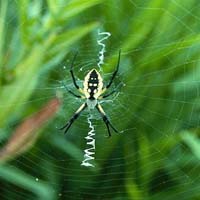Introduction to Spiders

Spiders come in many shapes, colors, and sizes, but they all have characteristics
in common. We all know spiders have eight legs. What other characteristics
make a creature a spider, and not an insect?
Physical Characteristics of Spiders
1) Two body
sections (an insect has three):
A) A cephalothorax
(combination head and thorax), which contains the brain, poison
glands, and stomach, is covered by a shield called a carapace.
B) An abdomen contains the heart, lungs, digestive tract,
reproductive organs, and the silk glands.
2) Nearly all
spiders have four pairs of simple eyes.
3) All spiders
have silk-producing spinnerets at the end of the abdomen. (see silk
section below)
Behavioral Characteristics
of Spiders
1) All spiders
are predatory, feeding on other smaller animals. Some spiders, for
example, the orb weavers, spin silk webs in which to catch prey. Others,
such as wolf spiders and jumping spiders, hunt down their prey.
2) Spiders kill
their prey by injecting them with venom from their poison glands.
The venom is injected using their fang-like chelicera.
Spider Habitat
Spiders can be found in nearly every conceivable kind of habitat.
The limiting factor appears to be the lack of available food to prey
upon. Many species live outdoors under natural surroundings and seek
shelter in ground litter, vegetation under rocks, or in crevices. Those
species that build webs may construct them in vegetation or are associated
with human dwellings. A few species, such as the house spider, cellar
spider, and brown recluse, have adapted to living inside houses. They
take advantage of the protection and warmth that our houses provide.
It has been stated that usually we are never farther than about eight
feet from a spider during most of our lives!
Life Cycle of
Spiders
Male and female spiders mate when they are mature. The female deposits
eggs (sometimes up to several hundred) in a silken sac. The young spiderlings
emerge weeks later (or the following spring).
Most spiders live for one or two seasons. Males often die shortly after
mating, while females of some species may live for years.
As they grow, spiders shed their exoskeleton.
Spider Silk
and Webs
A spider's abdomen contains four to seven silk glands that produce the
protein fiber. Each type of gland produces a different type of silk
(sticky silk, web frame silk, egg sac silk). The liquid silk goes through
the spinnerets at the rear of the abdomen. It hardens as it emerges.
Spider silk is a very strong substance. The spider uses its claws to
handle the strands of silk.
A simple use of
a strand of silk is a dragline. The spider lays down a line of silk
as it travels, attaching it to things at intervals, to act as a safety
line, or a path marker by which it can find its way back.
Another use of
a single strand is when a spider, on a tree branch or other high place,
lets out a line. The wind catches it and balloons it out, allowing the
spider to float down to a new place.
Spiders weave silk
webs of several basic shapes. They also use silk to make egg cases,
nurseries, tunnel liners, and trapdoors. The basic web types are cobwebs,
sheets, funnels, and orb webs.
 A
cobweb is a tangled mass of fluffy silk that catches insects.
A
cobweb is a tangled mass of fluffy silk that catches insects.
A sheet web (sometimes called a triangular web) is flat with
main lines running down the center. When an insect lands on the web,
the spider shakes it, causing the insect to struggle and get caught
in the strands.
A funnel web is built in the grass. The spider hides at the
small end and rushes out and grabs the insects as they come down the
funnel.
An orb web is shaped like a circle. The spokes are built first,
then the spiral connecting strands are added. Insects fly into the
barely visible orb.
Read a Living
Museum magazine article on Native American weaving titled
"The Gift of the Spider Woman" to learn about the meaning
of spiders in Mississippian culture.
Related Activities:
Spider Anatomy & Identification (html)
(pdf)
Spider Poem (html) (pdf)
Spider Gorget (html) (pdf)

